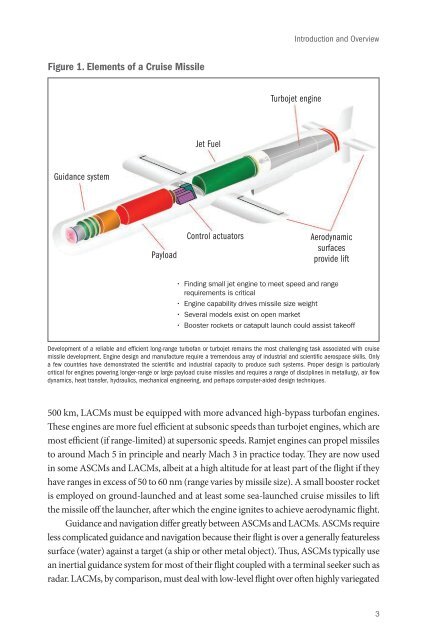You also want an ePaper? Increase the reach of your titles
YUMPU automatically turns print PDFs into web optimized ePapers that Google loves.
Introduction and Overview<br />
Figure 1. Elements of a Cruise Missile<br />
Turbojet engine<br />
Jet Fuel<br />
Guidance system<br />
Payload<br />
Control actuators<br />
Aerodynamic<br />
surfaces<br />
provide lift<br />
• Finding small jet engine to meet speed and range<br />
requirements is critical<br />
• Engine capability drives missile size weight<br />
• Several models exist on open market<br />
• Booster rockets or catapult launch could assist takeoff<br />
Development of a reliable and efficient long-range turbofan or turbojet remains the most challenging task associated with cruise<br />
missile development. Engine design and manufacture require a tremendous array of industrial and scientific aerospace skills. Only<br />
a few countries have demonstrated the scientific and industrial capacity to produce such systems. Proper design is particularly<br />
critical for engines powering longer-range or large payload cruise missiles and requires a range of disciplines in metallurgy, air flow<br />
dynamics, heat transfer, hydraulics, mechanical engineering, and perhaps computer-aided design techniques.<br />
500 km, LACMs must be equipped with more advanced high-bypass turbofan engines.<br />
These engines are more fuel efficient at subsonic speeds than turbojet engines, which are<br />
most efficient (if range-limited) at supersonic speeds. Ramjet engines can propel missiles<br />
to around Mach 5 in principle and nearly Mach 3 in practice today. They are now used<br />
in some ASCMs and LACMs, albeit at a high altitude for at least part of the flight if they<br />
have ranges in excess of 50 to 60 nm (range varies by missile size). A small booster rocket<br />
is employed on ground-launched and at least some sea-launched cruise missiles to lift<br />
the missile off the launcher, after which the engine ignites to achieve aerodynamic flight.<br />
Guidance and navigation differ greatly between ASCMs and LACMs. ASCMs require<br />
less complicated guidance and navigation because their flight is over a generally featureless<br />
surface (water) against a target (a ship or other metal object). Thus, ASCMs typically use<br />
an inertial guidance system for most of their flight coupled with a terminal seeker such as<br />
radar. LACMs, by comparison, must deal with low-level flight over often highly variegated<br />
3


